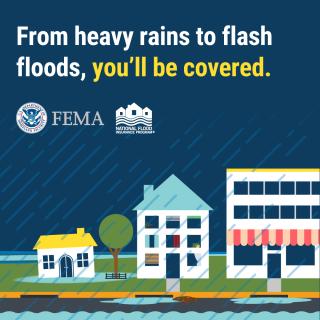Home Flood Mitigation Tips

Know Your Risk. Anywhere it can rain, it can flood. To check your specific flood risk, look up your address in the FEMA Flood Map Service Center.
Reduce Your Risk. By preparing now, you can protect your family, home and belongings from flooding.
Take Action. Make an evacuation plan in case of flooding, build an emergency kit or update your existing kit, inventory and keep important papers and valuables in a safe place, and get involved in helping others prepare.
Stay Informed. Sign up for emergency alerts and weather alerts through the National Weather Service, FEMA and North Beach text alerts www.northbeachmd.org
Insure Your Property. Flood damage isn’t covered by standard homeowners insurance policies, and flood damage is expensive. Just one inch of floodwater can cause more than $25,000 in damage. Talk to your insurance agent about flood insurance or visit www.floodsmart.gov.
Avoid Risk
- Flooding is a factor in more than 90 percent of disaster-related property damage in the United States
- Find out if you live, work, or travel through areas that are prone to flooding.
- FEMA creates flood maps, known as Flood Insurance Rate Maps (FIRMs), to show the locations of high and moderate risk areas.
- To check your flood risk, look up your address in the FEMA Flood Map Service Center.
- Flood maps provide a guide to flood-prone areas, but it is impossible to predict all flooding. Many areas outside the high-risk flood zone can flood. For example, if you live in an urban or suburban area, you might be at risk from flooding due to stormwater runoff.
- Reduce your risk by
Buy Flood Insurance
- Flood damage isn’t covered by standard homeowner’s insurance policies and just one inch of floodwater can cause more than $25,000 in damage.
- Everyone should consider flood insurance. Even if your home is in a low- or moderate-risk flood zone, purchasing flood insurance is a smart choice. More than 20 percent of flood insurance claims come from properties that are not in identified high-risk zones.
- Renters should purchase a flood insurance contents policy. Flood damaged household goods are rarely salvageable.
- Talk to your insurance agent about flood coverage or visit www.floodsmart.gov.
- If you already have flood insurance, check your policy and make sure you are aware of what is and is not covered and adjust coverage as appropriate.
Tips for Homeowners
- Review Your Landscaping
- Routinely clean and maintain gutters, downspouts, and splashpads so rainwater flows away from your house.
- Ensure any smart vents are not blocked.
- Clear debris from drainage ditches and storm drains.
- Improve your lot grading so stormwater will drain away from the building.
- Connect a rain barrel to your gutter downspouts to collect runoff from the roof. This non-potable water can be used to water your plants or wash your car.
- Seal Foundation Cracks
- Close any foundation cracks with mortar and masonry caulk or hydraulic cement, which expands and fills gaps completely.
- Seal walls in your basement with waterproofing compounds to avoid seepage, making sure floor drains are free of obstructions.
- Install a sump pump: Sump pumps propel groundwater away from your home and can be an excellent defense against basement seepage and flooding. Choose a battery-operated sump pump in case the power goes out.
- Consider purchasing a wet/dry vac to remove flood water quickly to reduce damage to carpets and drywall.
- Have sandbags or other flood barriers on hand to shore up any areas where floodwater is prone to enter your home (garage doors, basement doors, etc.) FEMA and local governments often distribute free sandbags to residents when flooding is predicted.
- Prevent Sewer Backups
- Install drain plugs for all basement floor drains to prevent sewer backups.
- Have a licensed plumber install sewer backflow valves for all pipes entering the building to prevent floodwater and wastewater from backing up into your home through toilets, sinks, and other drains.
- Elevate Appliances and Electrical Equipment
- Raise and anchor service equipment and appliances such as air-conditioning units, water heaters, heat pumps, and water meters onto platforms so they are at least one foot above the potential flood height.
- Move major appliances such as washers, dryers and hot-water heaters above the ground floor.
Online Resources
More information about preparing for floods can be found through the following websites:

